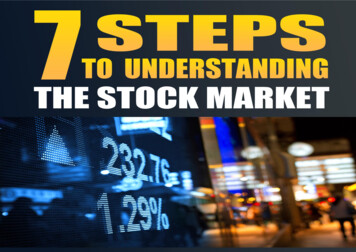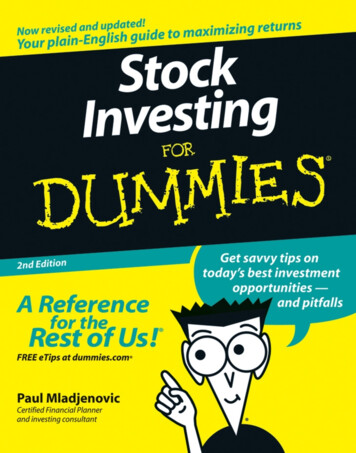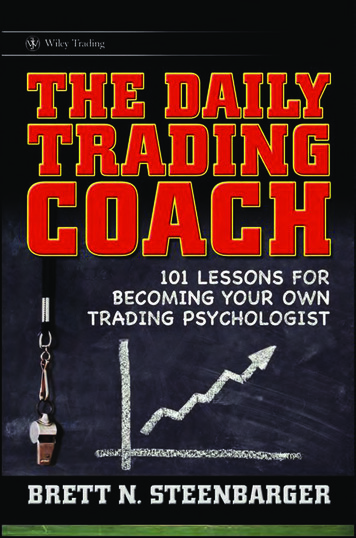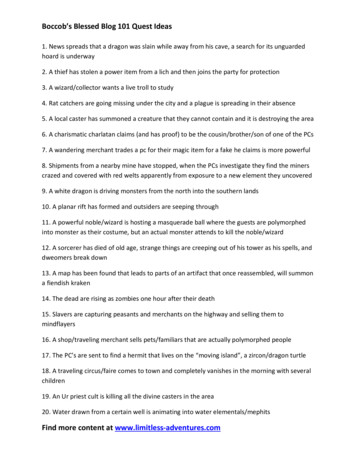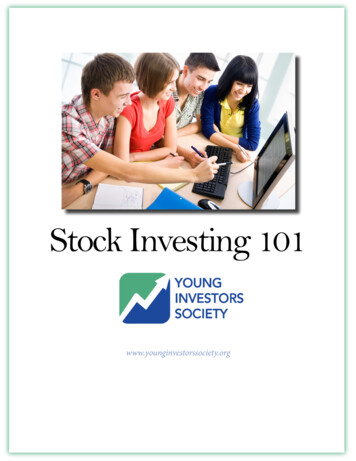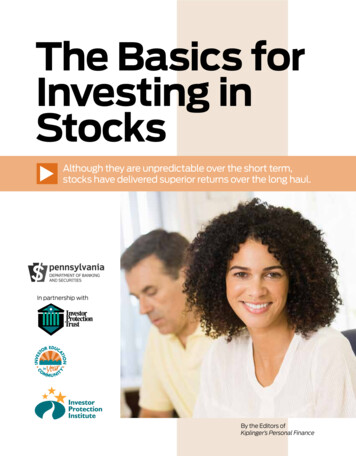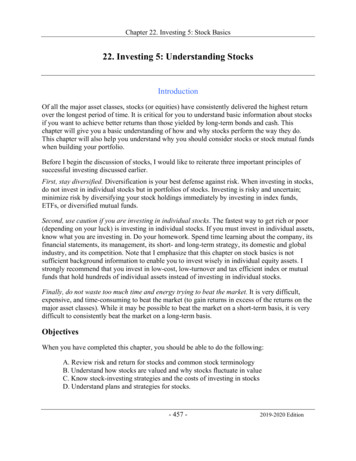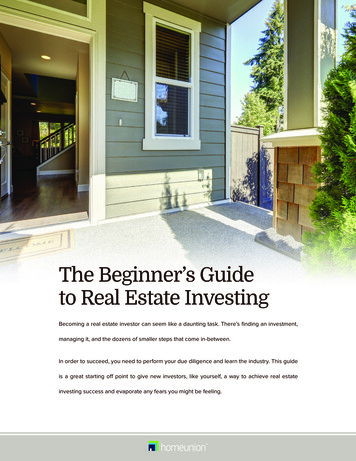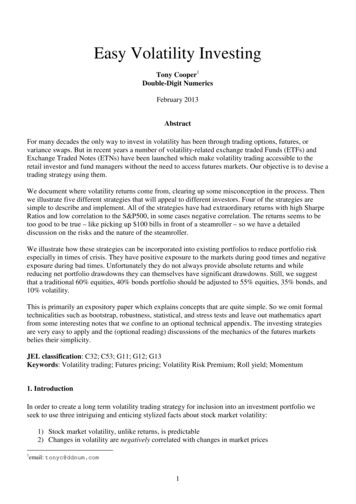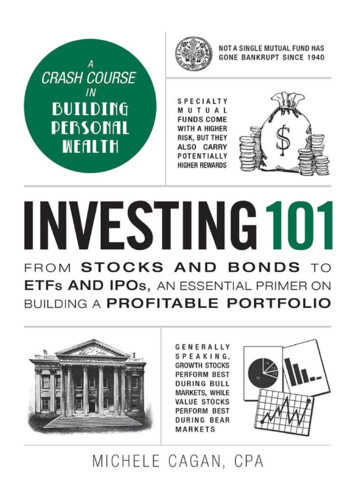
Transcription
Thank you for downloading this Simon & Schusterebook.Get a FREE ebook when you join our mailing list. Plus, get updates on new releases, deals,recommended reads, and more from Simon & Schuster. Click below to sign up and see terms andconditions.CLICK HERE TO SIGN UPAlready a subscriber? Provide your email again so we can register this ebook and send you moreof what you like to read. You will continue to receive exclusive offers in your inbox.
INVESTING 101FROM STOCKS AND BONDS TOETFs AND IPOs, AN ESSENTIALPRIMER ON BUILDING A PROFITABLEPORTFOLIOMICHELE CAGAN, CPAAvon, Massachusetts
CONTENTSINTRODUCTIONCHAPTER 1: BASIC ECONOMICSBUYING AND SELLINGINTEREST RATESECONOMIC INDICATORSSECTORSTHE SECGLOBAL ECONOMICSCOMPANY FUNDAMENTALSCHAPTER 2: WHAT ARE STOCKS?BUYING STOCK IN A COMPANYSTOCK EXCHANGESDIVIDENDSKINDS OF STOCKSCYCLICAL, DEFENSIVE, VALUE, AND PENNY STOCKSCHAPTER 3: BONDS, MUTUAL FUNDS, AND ETFsWHAT ARE BONDS?WHY BUY BONDS?BOND RATINGS AND YIELDSTREASURY AND MUNICIPAL BONDSCORPORATE BONDSMUTUAL FUNDSHOW FUNDS OPERATEFUND TYPESEXCHANGE-TRADED FUNDS (ETFs)MANAGING YOUR FUNDSCHAPTER 4: STYLES OF INVESTINGVALUE INVESTINGGROWTH INVESTING AND TECHNICAL INVESTINGDAY TRADING AND SHORT-TERM TRADING
CHAPTER 5: INVESTING IN REAL ESTATELEVERAGINGFLIPPING HOUSESRENTAL PROPERTIESREAL ESTATE INVESTMENT TRUSTSCHAPTER 6: CURRENCY AND COMMODITY TRADINGTRADING CURRENCIES AND DERIVATIVESCOMMODITIES AND PRECIOUS METALSOPTIONSSHORT SELLINGCHAPTER 7: EDUCATION AND RETIREMENT PLANNINGINVESTING FOR EDUCATIONRETIREMENT PLANNINGCHAPTER 8: SOCIALLY RESPONSIBLE INVESTINGGREEN INVESTINGSUSTAINABLE RESOURCE FUNDSCHAPTER 9: YOUR INVESTMENT PORTFOLIOINVESTING GOALSRISK ASSESSMENTDIVERSIFICATIONYOUR INVESTOR PROFILESTOCKBROKERSCHAPTER 10: ADVICE FROM THE PROSBENJAMIN GRAHAM (1894–1976)WARREN BUFFETT (1930–)PETER LYNCH (1944–)JACK BOGLE (1929–)
INTRODUCTIONWhen you hear the word “investing,” you probably think first of stocks, bonds, ormutual funds. These are certainly among the most common forms that investmentstake, but there’s more to investing than that.Investing is about getting your money to make more money. That’s the simplestdefinition of it. And there are all kinds of ways to do that. They include:StocksBondsMutual fundsPrecious metalsExchange-traded fundsReal estateCommoditiesCurrency tradingIn this book, you’ll learn about all these things and more. We’ll examine differentinvesting strategies and get advice from some famous investors such as theNebraska genius Warren Buffett and billionaire Peter Lynch. We’ll unlock themysteries behind those terms you hear sometimes on television or see online: shortselling, penny stocks, and economic indicators. You’ll learn about the variousexchanges such as the New York Stock Exchange and the NASDAQ, as well asinstitutions such as the Federal Reserve and the Securities and ExchangeCommission and how they impact investing choices.You’ll get advice on investing for education and for retirement. You’ll learn howto evaluate your risk tolerance. And you’ll learn some basics from the best investorsout there.Investing is a way of helping you reach your goals, whether those are paying foryour education or that of your children; traveling and having new and excitingexperiences; or financing a secure retirement. By investing wisely and well, you canexpand your savings and make your financial dreams come true. There’s an excitingworld filled with money-making opportunities out there, and it’s waiting for you totake advantage of it.Welcome to Investing 101.
CHAPTER 1BASIC ECONOMICSInvesting is about making your money grow. That can’t happen unless the securitiesyou invest in grow and pay out earnings. And that is directly tied in to the health ofthe economy.The most basic premise of the economy is this: If consumers spend money, theeconomy can grow; if they don’t, it can’t. When the economy is sluggish, consumerspending lags, overall corporate growth stagnates, and investors see poor returns.When the economy is booming, people spend money, corporations prosper, andinvestments grow. In fact, consumer spending makes up most of our gross domesticproduct (GDP), and that keeps the economy flowing.Understanding how the economy works, the cycles it goes through, and theimpact changes have on the markets can help make you a more successful investor.In fact, investors who pay attention to the economy can be more successful becausethey can take advantage of impending changes. While everyone else is focused onwhat’s happening right now, economically savvy investors can focus on what’scoming—and profitable investing is all about future growth.
BUYING AND SELLINGThe Lifeblood of the EconomyIt’s certainly the case that the economy today is a very complicated, fast-movingmechanism. How could it be otherwise? We live in a world inhabited by nearlyseven and a half billion people who are engaged in a never-ending interaction withone another. Some are buying; some are selling; some are manufacturing; some areconsuming. Economics as a system allocates the things we need to live.Broadly speaking, if you’re going to get involved in investing your money, youdon’t need to know a lot about how the economy works or the finer points of itsmore obscure corners. You do, however, need to understand some basic thingsabout it.“The intelligent investor is a realist who sells to optimists and buys frompessimists.”—Jason ZweigValue and PriceHumans buy and sell things because those things have value. This value is partlywhat you use them for (for instance, you use food to survive, you use a car fortransportation, and you use movie tickets for entertainment) and partly themonetary value that we assign to them (price).Value isn’t constant, though. The value of some things changes quickly. Forexample, you probably have noticed that the price of gasoline isn’t nearly as high asit was several years ago. That’s partly because humans are generally using lessgasoline for driving our cars. This means there’s a lower demand for gasoline, andthe price, correspondingly, drops. It’s also because many oil-producing countrieshave stepped up their production, which means there’s overproduction, causing theprice to drop. Gasoline prices fluctuate depending on demand and supply. If supplyincreases, prices fall. If demand increases, prices rise.Here are some other basic concepts you need to keep in mind.Income
Income is money you receive from different sources—your job, gifts, inheritances,investments—to buy what you need. Knowing your income is important, since thisallows you to live within your means and not spend more than you have coming in.Economists consider various kinds of income, including national income, per capitaincome (that is, the average income a person has), and disposable income (theamount of money you and your family can spend after you pay your taxes).Big changes in your life usually affect your income. One of the largest will comewhen you retire from your job (or jobs). At that point, you’ll lose a major source ofyour income, and you’ll need to replace all or some of it. Social Security will help,but this is also where your investments can play a key role in letting you maintainyour lifestyle.ConsumptionThis is what you and your family consume; that is, it’s how much you spend ongoods and services. Again, this is a very important thing for you to keep track of. Ifyour consumption is going up but your income is remaining the same or declining,you’ve got a problem. On the other hand, if your consumption holds steady, more orless, and is in line with your income, you’re sitting pretty.
Personal Consumption ExpenditureEconomists track personal consumption expenditures (PCE). TheBureau of Economic Analysis (www.bea.gov) monitors and publishesPCE reports regularly. You can also find information at the Bureau ofLabor Statistics (www.bls.gov).Saving and InvestmentFinally, we come to those things that families should do and don’t: save andinvest.Americans used to be quite good at saving—during the 1960s, the averageAmerican saved 6–10 percent of her or his income. That declined in the 1990s, andtoday it hovers around zero. Obviously it’s not in our interest to live paycheck topaycheck, but too many of us struggle to find ways to save and to increase thosesavings. This is the importance of investments. It’s not enough to save part of yourincome; you’ve got to get that money working for you.
INTEREST RATESBorrowing and LendingInterest rates are the prices borrowers of money pay to the lenders. From stocks tobonds to real estate, every investment is somehow affected by interest rates, albeitto a different extent. To understand that impact, you first have to understand howinterest rates work. For most of us, interest is just something we earn on oursavings accounts, or (more often) more money we have to pay to credit cardcompanies. For some, it’s the mysterious number connected with mortgagepayments. And that’s where it ends for us; that’s the direct impact of interest rateson our lives.It begins, though, with the Federal Reserve.
The FedThe Federal Reserve System was created in 1913 with theresponsibility of creating and maintaining interest rates andadministering U.S. monetary policy. Today, in addition to these things,it supervises and regulates banks and acts as a financial servicer forthe U.S. government and various lending institutions.The Federal Reserve has the power to manipulate the federal funds rate, which isthe interest rate that Federal Reserve banks charge other banks like yours to borrowmoney. That rate sets the tone for all other interest rates, like the ones on your carloan, mortgage, and credit cards. The Federal Reserve uses this rate to controlinflation. To keep inflation from spiraling out of control, the Fed raises its rate,which has the effect of limiting the amount of money available for consumerspending. Higher interest rates mean that more money goes to interest paymentsand less to shopping.When people and businesses have to pay more in interest, which leaves them lessto spend, investors can take a hit. So while a change in the federal funds rate doesn’timmediately impact the markets, it does affect them indirectly, through bothconsumer spending and corporate bottom lines. When corporations have to paymore to borrow money, that’s less money for the dividend pool and less money toput toward future growth. Plus, corporations with diminishing profits usually seetheir share prices drop right alongside the disappearing earnings. So even if nothingelse changes, an interest rate increase can push stock prices down.
The Effect of Lower RatesWhen the Fed lowers interest rates, the money supply increases. Thatoften signals investors to buy stocks, as lower interest rates makestocks appear more attractive on the risk/return scale. Lower ratesalso aid economic expansion, which leads to corporate growth, whichincreases the value of corporate shares.There’s a flip side to this, though. A higher federal funds rate also means higherinterest rates paid out on newly issued Treasury securities. These risk-freeinvestments guarantee you steady returns, and when rates go up, you’re guaranteedbigger interest payments on these government securities. This also has the effect ofhigher interest rates on newly issued municipal and corporate bonds.
ECONOMIC INDICATORSSignposts in the MarketplaceWhether the economy is poised to take a turn or remains on course, there arespecial economic statistics that give us clues to what’s about to happen. These cluesare called leading indicators, and, as their name suggests, they take the lead inpredicting which way the economy is headed. Then their cousins, coincident andlagging indicators, are used to confirm economic trends, illustrating where theeconomy stands now and where it’s been.“The idea that a bell rings to signal when investors should get into or out of themarket is simply not credible. After nearly fifty years in this business, I do notknow of anybody who has done it successfully and consistently. I don’t evenknow anybody who knows anybody who has done it successfully andconsistently.”—John C. BogleEconomic indicators are often tied with inflation. One reason for this is thatinflation strongly influences the level of interest rates, which impact the stability ofthe economy. Some are also linked with production or foreign trade, both of whicheventually impact consumer goods prices.Indicators and YouWhile you don’t need a degree in economics to be a good investor, you need tounderstand how and when the economy can impact your portfolio. It makes sensefor investors to have a thorough understanding of how the economy works and howeconomic activity is measured.
Leading IndicatorsThough economists also look at coincident and lagging indicators,investors typically focus on leading indicators. For an investor, profitsoften come from future events and expectations. Knowing where theeconomy is headed can help investors (especially traders) make moreprofitable investment choices at the most opportune times.Eight of the most important economic indicators are discussed here. You’veprobably heard of some of them, like the GDP, the consumer price index (CPI), theunemployment index, job growth, and housing starts. Others, such as the producerprice index, consumer confidence index, and business inventories, are less widelyknown but are important all the same.Gross Domestic ProductThe GDP is the most important economic indicator published. Providing thebroadest measure of economic activity, the GDP is considered the nation’s reportcard. The four major components of the GDP are consumption, investment,government purchases, and net exports. This lagging index takes months tocompute and even longer to finalize. The GDP lets us know if the economy isgrowing or shrinking.Consumer Price IndexThe CPI, released by the Bureau of Labor Statistics (BLS), is directly linked withthe inf
investing 101 from stocks and bonds to etfs and ipos, an essential primer on building a profitable portfolio michele cagan, cpa avon, massachusetts. contents introduction chapter 1: basic economics buying and selling interest rates economic indicators sectors the sec global economics company fundamentals chapter 2: what are stocks? buying stock in a company stock exchanges dividends kinds of .
